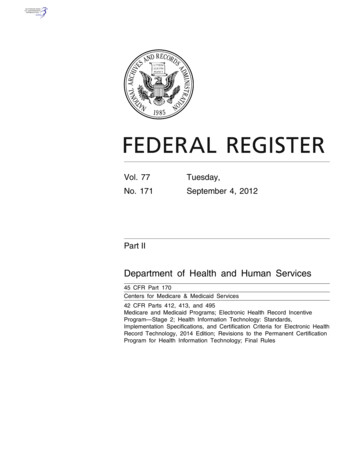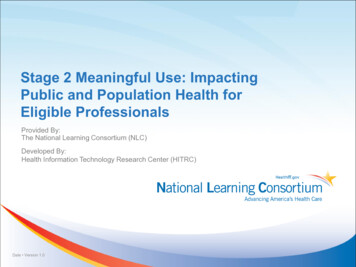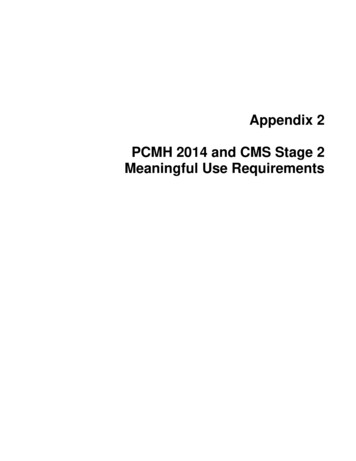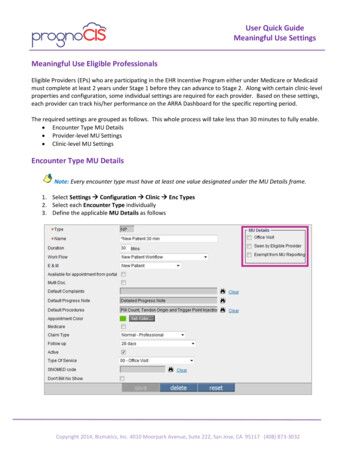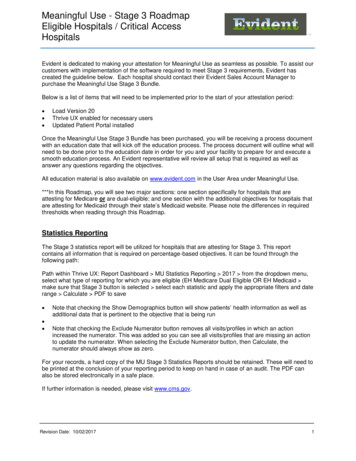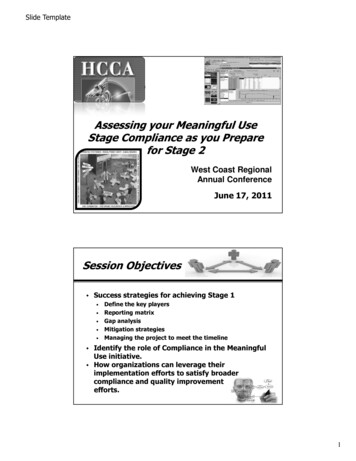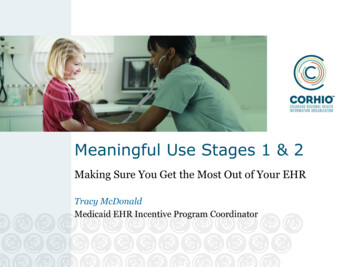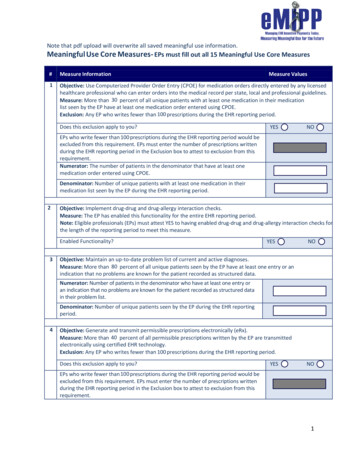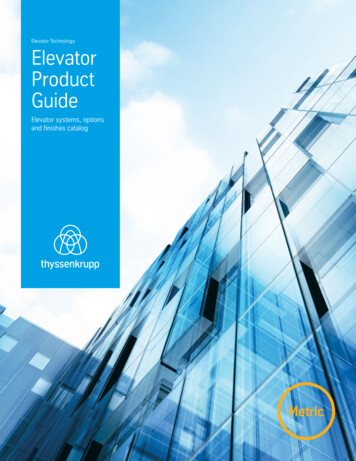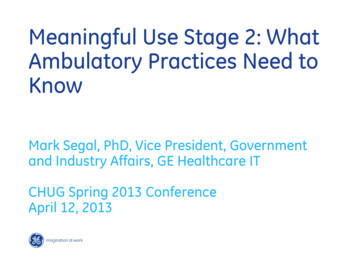
Transcription
Meaningful Use Stage 2: WhatAmbulatory Practices Need toKnowMark Segal, PhD, Vice President, Governmentand Industry Affairs, GE Healthcare ITCHUG Spring 2013 ConferenceApril 12, 20131Centricity LIVE Speaker Training4/22/2013
2012 General Electric Company – All rights reserved.This does not constitute a representation or warranty or documentation regardingthe product or service featured. All illustrations are provided as fictional examplesonly. Your product features and configuration may be different than those shown.Information contained herein is proprietary to GE. No part of this publication may bereproduced for any purpose without written permission of GE.DESCRIPTIONS OF FUTURE FUNCTIONALITY REFLECT CURRENT PRODUCT DIRECTION,ARE FOR INFORMATIONAL PURPOSES ONLY AND DO NOT CONSTITUTE ACOMMITMENT TO PROVIDE SPECIFIC FUNCTIONALITY. TIMING AND AVAILABILITYREMAIN AT GE’S DISCRETION AND ARE SUBJECT TO CHANGE AND APPLICABLEREGULATORY CLEARANCE.* GE, the GE Monogram, Centricity and imagination at work are trademarks ofGeneral Electric Company.General Electric Company, by and through its GE Healthcare division.2Centricity LIVE Speaker Training4/22/2013
Overview
HITECH Act and Meaningful UseHITECH ActPart of American Recovery & Reinvestment Act of 2009 (ARRA) 30B for HIT infrastructure and EHR adoption/useMeaningful UseEligible Professionals (EP) and Hospitals demonstrate “Meaningful Use” of CertifiedEHR to receive Medicare or Medicaid EHR incentivesEHR solution achievesEP/Hospital demonstratesCertificationMeaningful Use
Evolution of Meaningful UseStage 3Stage 2AdvancedclinicalprocessesStage 1Data captureand sharingImprovedoutcomesImprovepatient care
Stages of Meaningful UseApplies if incentiveor adjustment yearFirstPaymentYearStage of Meaningful Use Criteria by First Payment 14201520162017*3-month quarter EHR reporting period for Medicare and continuous 90-day EHR reporting period(or 3 months at state option) for Medicaid EPs. All providers in first year in 2014 use any continuous90-day EHR reporting period. (note mix of 3-month and 90-day)
Medicare EP incentive paymentsCalendaryearFirst calendar year in which the Eligible Professionalreceives an incentive payment20112012201320142015 2011 18,0002012 12,000 18,0002013 8,000 12,000 15,0002014 4,000 8,000 12,000 12,0002015 2,000 4,000 8,000 8,000 0 2,000 4,000 4,000 0 44,000 39,000 24,000 02016TOTAL 44,000
Medicaid EP incentive paymentsFirst calendar year in which the qualifying Eligible Professionalreceives an incentive paymentAdoptionyear20112011 21,2502012 8,500 21,2502013 8,500 8,500 21,2502014 8,500 8,500 8,500 21,2502015 8,500 8,500 8,500 8,500 21,2502016 8,500 8,500 8,500 8,500 8,500 21,250 8,500 8,500 8,500 8,500 8,500 8,500 8,500 8,500 8,500 8,500 8,500 8,500 8,500 8,500201720122018201320192014202020152021TOTAL2016 8,500 63,750 63,750 63,750 63,750 63,750Medicare and Medicaid Programs; Electronic Health Record Incentive Program; Proposed Rule, January 13, 2010, Federal Register, pp. 1844-2011 63,750
Stage 1 status2013 is third year of Stage 1Total payouts nearly 13B (through 2/2013)2013 transitions in some Stage 2/2014 changesLearnings driving preparation for Stages 2 & 3
Stage 1 Meaningful Use performanceOn average all thresholds greatly exceeded; each hadborderline providersDrug formulary, immunization registries and patient list mostpopular EP menu objectives Advance Directives, Clinical Lab Results, Drug Formulary for hospitalsTransition of care summary and patient reminders least popularEP menu objectives Transition of Care and Reportable Lab Results for hospitalsLittle difference between EP and hospitalsLittle difference among specialties in performance, butdifferences in exclusions and deferralsSource: CMS presentation to HIT Policy Committee, 2/6/2013
Meaningful Use paymentsSource: CMS EHR Incentive Program data, 4/2013
Meaningful Use achievementSource: CMS EHR Incentive Program data, 4/2013
Meaningful Use progress: context75 % eligible hospitals received MU or AIU incentive 73% are meaningful users Demonstrates financial commitment to implement EHRAbout 36% of Medicare EPs meaningful users 58% of Medicare EPs receiving incentives are specialistsAbout 44% of Medicare and Medicaid EPs made financialcommitment to implement EHRSource: CMS presentation to HIT Policy Committee, 4/2013
EHR adoption continues to grow71.85% of physicians have adopted EHRs as of 2012 accordingto the NCHS, up from 57% in 2011*69% of primary care physicians used EHRs in 2012, up by 50%from 46% in 2009: recent Commonwealth Foundation report**HIMSS Analytics reports large increases in % of hospitals inEMRAMSM Stages 5 (97%), 6 (83%), 7 (64%)***Meaningful Use has accelerated this growth, likelyfocused on EHRs with robust, certified functionality,including interoperability foundations*Hsiao CJ, Hing E. Use and characteristics of electronic health record systems among office-based physician practices: United States, 2001–2012.NCHS data brief, no 111. Hyattsville, MD: National Center for Health Statistics. 2012.**S. Thomson, R. Osborn, D. Squires, and M. Jun, International Profiles of Health Care Systems, 2012, The Commonwealth Fund, November 2012*** HIMSS Analytics press release, January 14, 2013
Stage 2
Stage 2 Meaningful Use Final RulesFinal Rules released August 2012CMS: revised objectives and measures for eligible professionals(EPs) and hospitalsONC: revised certification and standardsCMS/ONC Interim Final Rule: December 2012Final Rules only start of needed guidance
Final Rule highlights Stage 2 start delayed to FY/CY 2014 3-month quarter reporting period for all in 2014 – new (CQMscan’t be submitted till end of full year) New objectives and measures for Stage 2– Nearly all proposed are finalized– Menu: clinical notes Revisions to some Stage 1 criteria– Some start in 2013 and others 2014 Some thresholds lowered and new exclusions
Final Rule changes (selected)Enhanced HIE provisions per proposal/commentsRevised hospital-based definitionRevised CPOE denominatorMedicare non-MU “payment adjustments” start 2015Medicaid revisionsRevised certification criteria and processRead preamble & fullCFR text!
Key GE Healthcare CMS comments Overall: comments carefully reviewed and responded to Stage 2 timing and implementation: majority of comments received Measurement and reporting: e.g., transit. defn., exchange, CPOE CDS and Clinical Quality Measures: more flexible CDS, fewer CQMsbut no e-specifications when regulations published HIE and interoperability: loosened requirement to send to other vendor systemand allows NwHIN query models Patient engagement: lower thresholds and exclusions Access to imaging results: kept for providers, clarified and lower thresholds Specialist provisions
EPs: Meaningful Use Stage 2Jan./Feb. 2015Q1: 2014EPs can first meet MU for FY2014 – butno payments until after end of CYQ1: 20132014 certification available– test methods 12/2012Oct. 1, 2014Last date for EPs tostart CY2014 MUreportingEPs can submit CQMselectronically, completing2014 MU submission
2013 Changes for Stage 1Computerized Physician Order Entry(CPOE)Add alternative measure based on # of medorders created in reporting periodTiming: 2013 and onwardRecord and Chart Changes in Vital SignsAge limit increased for recording BP in patientsfrom ages 2 to 3; no age limit for height andweightTiming: Optional in 2013; required 2014 Exclusion if EP sees no patients 3 years orolder, if all three vital signs not relevant toscope of practice, if height and weight notrelevant to scope of practice, or if BP notElectronic Prescribingrelevant to scope of practiceAdditional exclusion for providers not within 10 Timing: Optional in 2013; required in 2014 miles of pharmacy accepting eRxPublic Health Reporting ObjectivesTiming: 2013 and onwardRequire that providers perform at least oneElectronic Exchange of Key Clinicaltest of CEHRT capability to send data to PHInformationagencies, except where prohibitedNo longer required for Stage 1Timing: Required in 2013 and onward (for allTiming: No longer required 2013 and onwardStage 1 public health objectives)Revised description of who can enter ordersinto EHR and have count as CPOETiming: 2013 and onward (regardless of stage)
Final Rules are just the beginningFAQs: OngoingMeaningful Use measure specifications: 11/2012“Final” certification test methods: 12/2012 Revisions to methods, data, tools: Q1 2013“Final” eCQM specifications: 12/2012 Continuing issues/adjustments
Stage 3
Stage 3CMS outlines expected themes in Final Rule Improve quality, safety and efficiency better outcomesDecision support for high priority conditionsPatient access to self-management toolsAccess to comprehensive patient data via robust, patient-centered HIEImproving population healthHIT Policy Committee Request for Comments lateNovember 2012 – comments January 14, 2013CMS: menu to core and no “delay” for Stage 3 startin 2016 – NPRM in early 2014
Stage 3 expected timeline August 2012 – HITPC draft preliminary stage 3 proposal November 2012 – RFC distributed January 2012 – RFC comments submitted Q2 2013 – HITPC draft stage 3 recommendations Q3 2013 – HITPC final stage 3 recommendations to HHS Q1/Q2 2014 – Stage 3 proposed rules Q3 2014 – Stage 3 final rules October 1, 2015 – Stage 3 starts for hospitals January 1, 2016 – Stage 3 starts for eligible professionals
Stage 3 Request for CommentsComments submitted on HITPC RFC January 2014Industry alignment on commentsGE Healthcare advocated more focused approach to Stage 3 Focus on encouraging and assisting providers to take advantage of substantialcapabilities from Stages 1 and 2, rather than adding extensive new meaningful userequirements and certification criteria Meaningful use and functionality changes should emphasize drivinginteroperability, accelerating momentum and deepening Stage 2 use CMS & ONC should continue to invest in aligned quality measurement Given timing issues from Stages 1 and 2, ONC and CMS should not start Stage 3until at least three years after Stage 2 start
Stage 3 RFC comment themes (660)Greater focus on clinical outcomes Empower flexibility to foster innovation, limit scopeTiming concerns Experience needed from Stage 2 before increasing thresholds, acceleratingmeasures, moving from menu to core Concerns about standards readiness to support Stage 3 goalsAddress interoperability limitationsMeaningful Use only one component of provider responsibilitiesContinue to invest in CQM alignment, infrastructure, standardsEnsure patient safety remains high priority and relatedrequirements synchronized with Meaningful UseSource: ONC presentation to HIT Policy Committee, 2/6/2012
Stage 2Requirements
Overall requirements: EPsMeet (or exclusion) 17 core objectives (Stage 1 15)Meet (or exclusion) 3/6 menu objectives (Stage 1 5/10)New and continuing exclusionsEPs report 9/64 CQMs (Stage 1: 6; NPRM 12/125)Almost all Stage 1 menu to coreSome new Stage 2 menuCQMs aligned with other quality initiatives
Meaningful Use conceptsChangeNo ChangeExclusions no longer count to meetmenu objectives50% of EP outpatient encounters mustoccur at locations equipped with certifiedEHR technology Do not reduce needed menu items But, if 3 exclusions, can attest to one Starts in 2014 for all stages Starting in 2013, EP cannot create record of anencounter without CEHRT at practice/location andthen later input information into CEHRTMeasure compliance objectivecomplianceNumerators can include events before,during, after reporting period for patientsin denominator Had been unclear in Stage 1
Greater (some) relevance to specialistsImaging results & information “accessible through” CEHRTState cancer registry and specialized registryContinued use of core/menu conceptNo changes to statutory eligibility but specialty-relevant“hardship exceptions” for “payment adjustments” Calls out radiologists, anesthesiologists, and pathologistsCMS modified hospital-based definitionONC changes to definition to CEHRT – more flexibilitySplit exclusion for vitals – height/weight from BP
Hospital-based EP definition relaxedEPs who demonstrate they: Fund acquisitions, implementation, and maintenance of CEHRT,including hardware and interfaces needed for MU Without reimbursement from hospital And use at hospital in lieu of hospital’s CEHR Can be “non-hospital based” and receive incentiveApplication process
Payment adjustments (penalties)Start in 2015 per HITECH if not meaningful user 2015 (1%), 2016 (2%), 2017 (3%) But, if HHS finds EP meaningful users less than 75%, beginning in 2018, penaltygrows 1 point annually up to 5% Hospital: annual update cut: 2015 (25%), 2016 (50%), 2017 (75%)Medicaid attestations for AIU will not prevent penaltyTo avoid 2015 penalty: meaningful use in 2013 –or first attest by 7/1/2014 (hospital) or 10/1/2014 (EP) Same timing offsets in out years
Penalties: “Hardship exceptions”Lack of internet accessNew EPs“Extreme” circumstances such as natural disastersScope of practice/specialties: anesthesiology, radiology,pathologyLack of control of CEHRT availability if practice in multiplelocations
Payment adjustments (penalties)*If demonstrated meaningful use in 2011 or 2012Payment Adjustment Year20152016201720182019Based on Full Year EHRReporting Period20132014201520162017If demonstrates meaningful use in 2013 for the first time (and so on)Payment Adjustment Year2015Based on 90 day EHRReporting Period2013Based on Full Year EHRReporting Period20162014201720152018201620192017To Avoid Payment Adjustments: Providers must continue to demonstrate meaningful useevery year to avoid adjustments in later years*Sequence applies to EPs and subsection(d) hospitals. If first attest in 2013, hospitals must attest by July 1, 2014and EPs by October 1, 2014 - to avoid 2015 penalty - same sequence in out years.
Transitions of care/referrals and HIECut test “Exchange of key clinical information” starting in 2013Transitions/referrals to core but stay at 50% (NPRM was 65%)More HIE: 10% TOC summaries sent electronically via CEHRT NPRM: all electronic exchange w/ different organization, EHR, vendor Final Rule: one successful test exchange with provider using EHR technologydesigned by different vendor or CMS-designated test EHRCMS to monitor/respond for Stage 3 and via other policy tools ifnot enough cross-vendor exchange: eliminate “walled gardens”CMS looks to more robust exchange in Stage 3 – including query
Transitions of care/referrals and HIESender must use CEHRTRecipient need not use CEHRTSummary must be received/measurement must address receiptTransport standards: Direct and two options “HISP” part of certification for Direct and option 1MU Final Rule counts in numerator when referring/transitioningprovider uses CEHRT to generate summary and provides viaNwHIN Exchange participant or per NwHIN governance Need not use certified transport capabilities/standards, but Summary must actually be accessed for transition/referral
Updated care summary contentCare plan field, including goals and instructionsCare team members beyond referring, transitioning,receiving providerUp-to-date problem list of “pertinent” current and activehistorical diagnoses, active medication list, active medicationallergy list (replaces 3 objectives)Meaningful Use reporting must confirm presence ofproblems, med, med allergiesOther fields can be blank
Public Health and HIEOngoing submission requires provider and public health agencies to identifyelectronic process for data to move from EHR to public health: efficient, automated,secure If ongoing from pre-2014, may use 2011 standards Must identify PHA capability within first 60 days of reporting period Registration with PHA within first 60 days is key, then depends on onboardingStates/PHAs may specify transport methods CMS clarifies: limits on state Medicaid flexibility re: transmission apply only to certified capabilities, which donot include PH transmissionState PH Agencies can use HIEs to collect EHR data from providers on their behalf inaddition to accepting direct provider to PH data submission HIE intermediaries can just capture the data for PH; or HIE intermediaries can accept data from EHRs and transform it into correct version of HL7 (must be certifiedas a module) If PHA uses HIE, can eliminate some exclusions based on PHA capabilities
MedicaidPatient volume Encounters expanded to more Medicaid services – zero pay visits Could increase pediatricians’ eligibilityCQMs New measures include several targeted to Medicaid patientsStates’ flexibility with PH measures for Stage 2 (same as Stage 1 new cancer registry measure) Would meet at least 1 PH from menu if state moves 1 to core
Attestation for MU measuresGenerally unchanged from Stage 1Group report option allowing individual EP datato be uploaded in a batch file
DefinitionsReporting period Clarifies 90 days for first year of MU, regardless of payment year For 2014, reporting period is 3 month quarter for all Medicare and option of stateMedicaid to use 90-days or 3-month quarterCQMs part of “Meaningful Use” vs. an Objective in 2013 Office visit In Proposed Rule, CMS defined as “any billable visit that includes: (1) concurrentcare or transfer of care visits; (2) consultant visits; or (3) prolonged physician servicewithout direct, face-to- face patient contact (for example, telehealth). In Final Rule,CMS states that “in some cases removing sutures or giving allergy shots do notrepresent an office visit if that is the only service provided.” Relevant to reporting for patient summary and other objectives
Denominators: EPsCMS standardizes on four denominators1. Unique patients “seen by” EP during reporting period(stratified by age or previous office visit)– “Seen by” clarifications including if no physical or telemedicine contact (latter must definesome visits as “seen by”)– Flexibility for EPs practicing in multiple locations using different CEHRT or switching CEHRTduring reporting period2. Number of orders (medication, labs, radiology)3. Office visits: definition adopted as proposed– Need not be billable4. Transitions of care/referrals: definitions refined
CQMs for EPsEPs to report 9/64 clinical quality measures, covering at least3/6 domains*CMS recommends core set of 9 adult BP-focused measures &alternate pediatrics core of 9Medicare EPs participating in both PQRS & EHR IncentiveProgram can use PQRS Reporting OptionCMS issued eSpecifications in October 2012 that were “finalized”December 2012 with revisions in Q1: 2013*Patient and Family Engagement, Patient Safety, Care Coordination, Population and Public Health, Efficient Use of HealthcareResources, Clinical Process/Effectiveness
CQM reporting: EPsAttestation (Stage 1, Year 1)*Report individually or as groupOptions PQRS EHR reporting option – patient level (after year 1, PQRS and MU) CMS portal – aggregate data using QRDA III formatFor 2014 quarter reporting, CQM reporting in 2 months afterend of full CYTwo group reporting options for EPs ACO or PQRS-group: if report using CEHRTMedicaid reporting may vary by state*Providers can only use CQMs for which CEHRT is certified and CEHRT must be certified for “incorporate”, “calculate” and “reporting”
Care Summaries
Clinical Summary Content: Stage 2Patient NameList of diagnostic tests pendingProvider's name & office contact informationClinical instructionsDate and location of the visitFuture appointmentsReason for the office visitReferrals to other providersCurrent problem list & any updatesFuture scheduled testsCurrent medication list & any updatesCurrent medication allergy list & any updatesDemographic information maintained withinCEHRT (sex, race, ethnicity, date of birth,preferred language).Procedures performed during the visitSmoking status (New for Stage 2)Immunizations or medications administeredduring visitCare plan field, including problems, goals andinstructions. (New for stage 2)Vital signs taken during the visit (or otherrecent vital signs).Recommended patient decision aids (ifapplicable to the visit) (New for Stage 2)Laboratory test resultsFor EP Visit
Summary of Care Content: Stage 2Patient NameReferring or transitioning provider's nameand office contact information (EP only)*Care plan field, including problems, goals andinstructions*ProceduresCare team including the primary care providerof record and any additional known care teammembers beyond the referring or transitioningprovider and the receiving provider*Encounter diagnosisReason for referral* (EP only)ImmunizationsDischarge instructions (Hospital only)Laboratory test resultsCurrent problem list (historical at discretion)Vital signsCurrent medication listSmoking status*Current medication allergy listProvider's name & office contact infoFunctional status, including activities of dailyliving, cognitive and disability*Demographics (preferred language), sex, race,ethnicity, date of birth**New for Stage 2All can be blank if no EHR infoexcept problems, meds, medallergies.
EP Online Access Content: Stage 2Patient nameProvider's name and office contactinformationCurrent and past problem listProceduresVital signs (height, weight, blood pressure,BMI, growth charts)Smoking status*Demographic information (preferredlanguage, sex, race, ethnicity, date of birth)Laboratory test resultsCare plan field(s), including goals andinstructions*Current medication list and medicationhistoryAny known care team members including theprimary care provider (PCP) of record*Current medication allergy list andmedication allergy history*New for Stage 2Revised in Final Rule for view, download, transmitAll can be blank if no EHR info except problems,meds, med allergies.49Centricity LIVE Speaker Training4/22/2013
Objectives &Measures
Stage 2 EP MU objectivesCore SetMenu Set (Pick three)Computerized provider order entry for Med, Labs, and Radorders (3 measures)Imaging results (10%)eRx (50%)Record demographics (80%)Vital signs (80%)Smoking status (80%)Clinical decision support5 CDS “Interventions”Drug-drug; drug-allergy checksIncorporate lab test resultsGenerate patient listsPatient RemindersView online, download, transmit info about an office visitClinical Summaries for each office visitPatient education resourcesSecure electronic messagingMedication reconciliationSummary of care record for each transition of careSubmission to immunization registriesProtect electronic health informationFamily health history (20% of unique patients)Syndromic surveillanceCancer registrySpecialized registryProgress notesLegendStage 1 but modified for Stage 2Unchanged requirementNew requirement
Comparison Stage 1 to 2 for EPMenu to Core Incorporate lab data Generate patient lists Patient Reminders Timely Access Patient education Resources Med Reconciliation Transition of Care Summary Immunization RegistryStill Menu: Syndromic SurveillanceRaising the Bar CDS to 5 “Interventions” plus DD/DA Clinical Summary to patient from 3 days to 24hours*CPOE changes: include denominator to all orders% Increase CPOE* – 30% to 60% for medsDemographics – 50 to 80%Vitals – 50% to 80%Smoking status – 50% to 80%Incorporate Lab – 40 to 55%eRx – 40% to 50%New Imaging Results (40% to 10% of tests orderedfrom NPRM) CPOE for lab and imaging* Family Health History View, Download, Transmit (10% to 5%) Cancer Registry Specialized Registry Secure Electronic Messaging (10% to 5%) Progress Notes
MoreEliminated as Separate Objective Problem List Active Med List Medication Allergy List Clinical Quality Measures Drug-drug, Drug-Allergy eCopy of Health Info Drug Formulary
Certification
ONC HIT Certification ProgramTemporary program sunset on effective date with 6 months to finish existing work inprogress – no new requestsONC-ACBs cannot “update” 2011 modular certifications to 2014 but, for unchangedcriteria, “gap certification” allows use of applicable 2011 test results for modules, butstill must address QMS, automated measure calculation, safety-enhanced designRevisions to EHR module certification requirements Privacy and security certification– Base EHR definition includes all P&S certification criteria Other changes to make certification “more efficient”– Revised definition of CEHRT: Base, Core, Menu– Revised process to provide industry with flexibility to quickly use newer versions of“minimum standard” code sets on voluntary basis Application of specific new criteria– § 170.314(g)(1): Automated numerator recording– § 170.314(g)(3): Safety-enhanced design– § 170.314(g)(4). Quality management system
Certification test methods/scriptsSept–Dec 2012: TestProcedures out for commentTest procedures finalized inDecember - revisions tomethods, data, tools throughFebruary2014 certifications startedearly 2013
Certified EHR Technology redefinedCertified EHR Technology (CEHRT)Revision starts with 2014 reporting period but providers can use2014 in 2012/13“Possession” for 2012/13 unless use 2014 editionNew definition regardless of provider’s stage
Meeting CEHRT definitions: optionsComplete EHRModule(s) sufficient for provider MU Combination of modules Single module52% ofhospitals usedmodularelements**Modular/Complete* Can combine vendor and self-developedCan use alternate certified modules to those in Complete EHR - need CHPL #Can use alternate solutions by DepartmentAll software used to meet meaningful use criterion must be certifiedAncillaries/data sources* Certification needed only if capability used to meet meaningful use* /onc regulations faqs/3163 - 8/13/2012** nk-mass-consolidation - 8/13/2012
CEHRT complianceMeaningful Use Reporting PeriodFY/CY 2011-2013: Stage 1All EPs, EHs, and CAHs must have:1) EHR technology that has beencertified to all applicable 2011 EditionEHR certification criteria or equivalent2014 Edition EHR certification criteriaadopted by Secretary; or2) EHR technology certified to 2014Edition EHR certification criteria thatmeets Base EHR definition and wouldsupport objectives, measures, andability to successfully report CQMs, forMU Stage 1FY/CY 2014: Stage 1 or 2All EPs, EHs, and CAHs must have EHRtechnology certified to 2014 EditionEHR certification criteria that meetsBase EHR definition and would supportobjectives, measures, and ability tosuccessfully report CQMs, for MUstage that they seek to achieve
CEHRT: Base, Core, MenuWhat varies is quantity of EHRtechnology certified to 2014 Edition EHRcertification criteria that will be neededBase: EP/EH/CAH must have EHRtechnology with capabilities certifiedto meet definition of Base EHR (even ifexclusions apply)MU Core: EP/EH/CAH only needs tohave EHR technology withcapabilities certified for the MU coreset objectives & measures for stageof MU they seek to achieve unlesscan meet an exclusionMU Menu: EP/EH/CAH only needsto have EHR technology withcapabilities certified for MU menuset objectives & measures forstage of MU they seek to achieveSource: ONC MU2 presentation, August 23, 2012
Base* EHR criteriaCertification Criteria Required to Satisfy the Definition of a Base EHRCapabilitiesCertification CriteriaIncludes patient demographic and clinical healthinformation, such as medical history and problem listsDemographics § 170.314(a)(3)Vital Signs § 170.314(a)(4)Problem List § 170.314(a)(5)Medication List § 170.314(a)(6)Medication Allergy List § 170.314(a)(7)Capacity to provide clinical decision supportDrug-Drug and Drug-Allergy Interaction Checks §170.314(a)(2)Clinical Decision Support § 170.314(a)(8)Capacity to support physician order entryComputerized Provider Order Entry § 170.314(a)(1)Capacity to capture and query information relevant tohealth care qualityClinical Quality Measures § 170.314(c)(1) & (2) (capture &export, import and calculate) and specific CQMsCapacity to exchange electronic health information with,and integrate such information from other sourcesTransitions of Care § 170.314(b)(1) and (2)Data Portability § 170.314(b)(7)View, Download, and Transmit to 3rd Party § 170.314(e)(1)Capacity to protect the confidentiality, integrity, andavailability of health information stored & exchangedPrivacy and Security § 170.314(d)(1)-(8)*“Base” definition to be used as a checklist by providers to ensure they meet CEHRT definition; it is not a type of EHR.Base includes CQMs not in this table.
Pre-2014 roll-out of 2014 Edition EHRProviders can implement 2014 Edition in 2013, allowing moreflexible deployment scheduleProviders can use mix of 2011 and 2014 CEHRT ONC cross-walk between 2011/2014 Stage 1 criteria Complete EHR must be either 2011 or 2014, not mixEssential to work through MU reporting and other issues forthose using 2014 EHR before FY/CY 2014Incentives for 2014 don’t come faster if attest in earlier quarterunless in first year of Stage 1
Standards
Diagnosis, problem, and procedureSNOMED CT for problems but need not display SNOMED CTso long as user interface maps to SNOMED CTICD-10 or SNOMED-CT for encounter (billing) diagnoses, ONCcited available ICD-10:SNOMED-CT mapsSNOMED CT or CPT/HCPCS for procedures, with ICD-10-PCSand CDT as eligible for optional certificationONC removes “encounter diagnosis” from view, download,transmit but retains for TOC and portability
Next Steps
Key implications and action steps for GEHealthcare partners and GE Healthcare Review the rules and engage in/monitor discussions Assess your gaps in workflows, both MU and CQM Understand shifts from menu to core Plan for increased thresholds: eRx, CPOE, e
capabilities from Stages 1 and 2, rather th an adding extensive new meaningful use requirements and certification criteria Meaningful use and functionality changes should emphasize driving interoperability, accelerating momentum and deepening Stage 2 use CMS & ONC should continue to invest in aligned quality measurement
